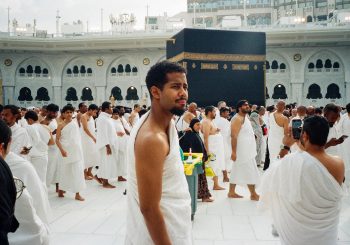In the seemingly endless expanse of Egypt’s Western Desert, a collection of hidden treasures is revealed to those who seek the allure of untouched landscapes and the echoes of ancient civilizations.
These are the oases of Egypt – lush, vibrant pockets of life amidst arid terrain, where history, nature, and culture intersect in a tapestry of captivating stories and unique experiences. Each oasis is a testament to the resilience of life in the harshest of environments, offering a glimpse into a world that has remained remarkably unchanged for centuries.
From the tranquil shores of Lake Qarun to the timeless charm of Siwa, the intriguing wonders of Bahariya, and the historical riches of Al-Dakhla, Al-Kharga, and beyond, Egypt’s oases stand as refuges of life that await exploration.
Here are six Egyptian oases, where the sands of time reveal their secrets and where the embrace of nature and history intertwine.
Siwa, Marsa Matrouh
Siwa oasis. Photo credit: Michael Hermann.
After traversing Egypt’s barren deserts for hours, the sight of Siwa’s lush greenery offers a warm welcome. Countless palm trees stand sentinel between the Great Sand Sea of the Sahara and the azure waters of the oasis, providing shelter from the sun, a home for wildlife, and a lifeline for the locals.
Throughout history, Siwa has been a refuge for weary desert travelers seeking water, sustenance, and answers. Among its notable visitors was none-other-than Alexander the Great, who came to consult the legendary oracle. He arrived a mere mortal and left as a declared son of the Egyptian god Amun.
Siwa is an ideal spot for a few days of relaxation. Despite its small size, the town brims with attractions. Over 300 pristine water springs, hot pools, and salt mining sites grace the sanctuary, celebrated for its natural beauty, including Bir Wahed, Cleopatra’s Pool, and Fatnas island.
Siwa’s people, descendants of North African Berber nomads, possess a unique culture characterized by traditional handicrafts, a distinct language, and local building materials like salt-infused clay.
Siwa’s date trade remains crucial to its economy and culture in the modern era. The annual harvest is marked by communal gatherings and date sharing. The rhythmic sound of date-picking resonates through palm groves, symbolizing the enduring bond between humans and the land. These prized dates, known for their exceptional taste, are sought-after delicacies reaching markets far beyond the oasis.
Al-Bahariya Oasis, Al-Giza

Just 365 kilometers from Cairo, Bahariya Oasis is Egypt’s most accessible oasis in the Western Desert. Its historical importance is deeply ingrained with roots tracing back to the ancient Egyptians. Its strategic placement along the Libya–Nile Valley caravan routes granted it a thriving role in agriculture and commerce.
Within Bahariya Oasis, there is a lot for visitors to do. Ghurd Al-Ghurabi, a part of the Abu Muharrik dune system, and the enigmatic Black Desert, with its volcanic hills capped in black, are noteworthy attractions. Crystal Mountain, or Gebel ِAl-Izzaz, is a geological wonder adorned with glistening quartz crystals. English Mountain, or Gebel Al-Ingleez, offers panoramic views and the remnants of a World War I observation post.Gebel Al-Dist, recognized for its pyramid-like silhouette, stands as another prominent landmark.
The Valley of Golden Mummies was unveiled, revealing over 100 exceptionally well-preserved Graeco-Roman mummies. The oasis boasts hot and cold springs, renowned for their mineral-rich waters.
Lake Marun, a salt lake in Al-Bahariya, is a vital haven for migratory birds and a perfect setting for capturing mesmerizing sunsets. Qarat Qasr Salim, a site steeped in history, houses rock-cut tombs adorned with intricate decorations, offering a glimpse into the opulence of a prosperous 26th Dynasty family.
Lake Qarun, Al-Fayoum

Amidst the ever-shifting, lifeless dunes of the Western Desert lie lush, green fields enveloping the vast Lake Qarun, like a secret that is best kept hidden.
Located 20 kilometers to the north of Al-Fayoum and about 80 kilometers southwest of Cairo, Lake Qarun is renowned as one of Egypt’s invaluable natural assets.
Once part of the extensive Moeris Lake, today, the lake is a smaller body of saline water, with a surface situated 43 meters below sea level, encompassing an area of approximately 214 square kilometers.
The area is protected because of its significance for both human and avian populations and its unparalleled historical, scientific, and natural significance.
Thousands of migratory birds, including flamingos, grey herons, spoonbills, and numerous waterfowl species, seek refuge in the vicinity of the lake during the winter migration. Lake Qarun serves as a sanctuary and spawning ground for numerous resident and migratory bird species, some of which are threatened with extinction.
Al-Farafra, Al-Wadi Al-Gadid

With an economy that thrives on agriculture, livestock, and tourism, Farafra, a quaint oasis town with around 7,000 residents, holds a rich and intricate history. The town’s architecture mirrors its past, featuring one-story clay brick buildings topped with wicker roofs gathered around the remnants of the Qasr El Farafra fortress. This fortress, once a refuge during tribal conflicts, now stands in ruins due to an unusually heavy rainstorm in 1958.
Qasr El Farafra also hosts a bustling weekly market on Thursday mornings. Nearby, a serene palm tree grove creates a forest-like haven, nurturing an oasis ecosystem. Just a short distance away, the oasis boasts natural hot springs, offering relaxation and a chance to admire mesmerizing sunsets.
Farafra has undergone a notable transformation in recent years, blooming into a vibrant community with multi-story structures and paved streets, opening its arms to a diverse population.
Farafra’s White Desert is a protected natural marvel, showcasing breathtaking rock formations shaped over time by wind and weather, presenting an abstract exhibition of intricate designs.
As night blankets the White Desert, stars shine in the sky, and the moon’s gentle radiance transforms the white expanse into a celestial canvas. This interplay of light and landscape conjures a magical atmosphere, inviting visitors to immerse themselves in the boundless cosmos.
Al-Dakhla, Al-Wadi Al-Gadid

Dakhla, the most renowned Egyptian oasis, is located on the Western Desert circuit road dotted by several humble, picturesque villages.
Deir al-Hagar, known as the Monastery of Stone, lives up to its name with its sandstone construction. This temple, devoted to the Theban Triad Amun-Re, Mut, Khonsu, and Seth, was reconstructed during the rule of the Roman Emperor Nero in 54 A.D.
At the heart of Dakhla Oasis, the Ethnographic Museum in Mut offers a captivating peek into local culture. Designed like a traditional Islamic home, it displays artifacts from Islamic eras, such as rugs, dresses, baskets, jewelry, and pottery.
Nestled beneath rose-tinted limestone cliffs within the lush oasis, Al-Qasr takes the spotlight as Dakhla’s centerpiece. With its winding alleys, medieval mud-brick houses, a 10th-century madrassa, a 12th-century mosque graced by a three-story minaret, and vibrant workshops, it stands as a captivating historical monument.
Qarat al-Muzawwaqa, or the “Decorated Hill,” takes its name from the ornately embellished tombs of Pelusis and Petosiris. The hill is also home to numerous simple family graves belonging to middle-class households.
Al-Kharga, Al-Wadi Al-Gadid

Kharga Oasis, also known as the Great Oasis, stretches 160 kilometers from north to south and 20 to 80 kilometers in width. An ancient lake that dried out millions of years ago left behind fertile silt, transforming agriculture into the backbone of the local economy. In addition to date palms, cereals, and vegetables, notable exports include hand-woven palm fiber baskets and mats.
Around 60,000 people call this oasis home, including a growing number of Nubians resettled from regions submerged by Lake Nasser. The landscape of Kharga is graced with Roman forts from the third and fourth centuries B.C., guarding the crucial trade route known as the “Forty Days Road.”
In the former capital of Kharga, Hebet, the Hibis Temple dates back to the sixth to fifth centuries B.C. This temple pays homage to the Theban triumvirate: Amun-Ra, Mut, and Khonsu. Historically, decrees were posted on the embellished walls of gates. Columns with palm-leaf capitals lead to a secluded courtyard, while the sanctuary boasts intricate religious scenes.
On 6 September and 7 April, the sanctuary of the ancient Temple of Hibis is graced by the sun’s illuminating rays.
Near Gebel El Teir, the Bagawat necropolis stands as one of the world’s earliest Christian cemeteries, boasting well-preserved tombs. Adorning 263 graves, two chapels feature frescoes depicting biblical themes. Winding streets, reflecting different styles, connect these graves that mirror affluence and style.
Among Kharga’s twenty fortresses, Qasr Al-Labeka once sheltered a Roman garrison safeguarding trade routes. Its towering walls, circular defense turrets, and the ruins of brick structures vividly illustrate its historical significance. Nearby, numerous necropolises harbor over 500 mummies and exhibit treasures like gilded masks and bronze jewelry.
Subscribe to the Egyptian Streets’ weekly newsletter! Catch up on the latest news, arts & culture headlines, exclusive features and more stories that matter, delivered straight to your inbox by clicking here.






Comments (2)
[…] The Jewels of the Sands: Egypt’s Oases Are Hidden Treasures Awaiting Exploration […]
[…] post The Jewels of the Sands: Egypt’s Oases Are Hidden Treasures Awaiting Exploration first appeared on Egyptian […]